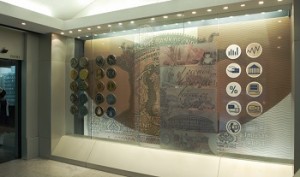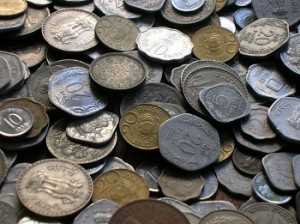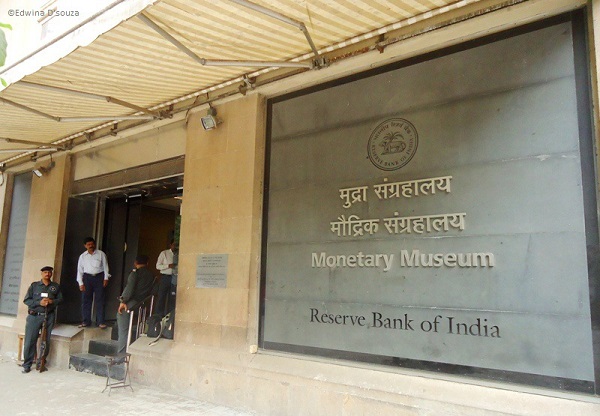Our coins are made of ferritic stainless steel, and have a mint mark which reveals where the coins were made. Read on for more.
by Ritika Bhandari Parekh
It all started when my cousin asked me to find out places in Italy which she could visit on her own. Her husband, who had work to finish said, “There isn’t much to see, except museums and more museums.” She retorted, “I don’t mind the museums at all.” This got me thinking and looking for ‘her’ kind of places, and I thought about the museums in Mumbai.
A quick search revealed that I had been to most of them as a schoolchild. But, wait! There was a new addition to the list – The Monetary Museum by Reserve Bank of India (RBI). While most of us in Mumbai are game to visit international museums, how many have actually visit this fascinating one in their own city?
 This numismatic museum officially opened in 2004 at the hands of the then Indian President Dr APJ Abdul Kalam. Situated in the commercial Fort area of South Mumbai, the museum building is located in the business district on Pherozeshah Mehta Road. If you wander a little ahead, the famous Strand Book shop is right around the corner.
This numismatic museum officially opened in 2004 at the hands of the then Indian President Dr APJ Abdul Kalam. Situated in the commercial Fort area of South Mumbai, the museum building is located in the business district on Pherozeshah Mehta Road. If you wander a little ahead, the famous Strand Book shop is right around the corner.
After depositing my bag in a locker and being issued with a strict ‘No Photographs please’ warning, I started my tour alone.
The museum is divided into six sections, with each section enlightening us on different ideas. The first section talks about ‘Concepts, Curiosities and the Idea of Money’. It takes us through the era of the barter system and explains how grains, cattle, implements were used. The evolution to precious metals, coinage and paper money is also explained here. On display are curiosities like the Neolitihic stone axes from 10 millenium B.C, as also cowri shells and beads from the A.D. era.
What caught my fancy was a square-shaped miniscule coin from the 3rd century BC, a silver bar from South East Asia, as also one shaped as a knife served as a token of money. A huge rectangular Indian note of Rs 10,000 (I am not kidding) was also on display.
If observed closely, an early 20th century cheque book of the Bank of India (BOI) Ltd, reveals three languages on it – English, Hindi and Gujarati (an indication of how the Gujarati business class was always an important part of the city). A counting tray from South India for the many fanams or small circular coins and other interesting articles are displayed in glass boxes.
of how the Gujarati business class was always an important part of the city). A counting tray from South India for the many fanams or small circular coins and other interesting articles are displayed in glass boxes.
Section 2 on Indian coinage is vast and comprises every kind of medieval coinage used by the Indian Princely States. It also houses coins from the pre-Colonial era. A quick look reveals that metals such as gold, silver and copper were the favourites among the kings. So Akbar, Tipu Sultan and Shivaji had golden mohurs of different values. It is also interesting to note the inscriptions on these coins.
From deities to names to zodiac signs in which the coins were made, all have made their mark on the money trail. It is said that before the East India Company was taken over by the British Crown in 1858, there were over a 100 princely States that had the right to issue coins. So the museum and its curators have done a splendid job in bringing not only the famous Mughal era coins, but also the coins from the North-Eastern States and the koris and dokdos from the Kutch kingdom.
As we end the section, a display of Indo-European coins and the commemorative coins by the Indian Government greet us. For the uninitiated, 1988 was the year of Aurobindo Ghosh and his saying that ‘All life is yoga.’ And so, we walk through the third section of ‘From coins to bank notes’. My Organization of Commerce (O.C.) lectures started playing in my mind, as I read about promissory notes, bills of exchange and payment hundis.
Section 4 on Indian paper money, reveals the metamorphosis of the Indian currency. Paper money from the British and post-Independence days make their way to the displays. A peculiar and striking feature of most of the notes were the portraits of the British rulers, like King George, on them.
The fifth section talks about ‘Knowing your currency’. It helps us understand the difference between a real and a counterfeit note. I learnt that the motif of the tractor on the five-rupee note was to symbolise the green revolution, and that the two-rupee note had an Aryabhatta satellite. Interestingly, our current 500-rupee note uses raised intaglio printing for the blind community.
The last section is called ‘RBI and You’ and is devoted to the activities of the main central bank of India. There is also a wall of portraits of all the presidents of RBI, since its inception in 1937.
And then, just like that we come to the exit. The Monetary Museum revealed a lot and keeping all that in mind, I am back on the sunny, crowded and chaotic street outside.
(Pictures courtesy www.eumo.in, wannabemaven.com, strayingaround.blogspot.com. Images are file pictures)
